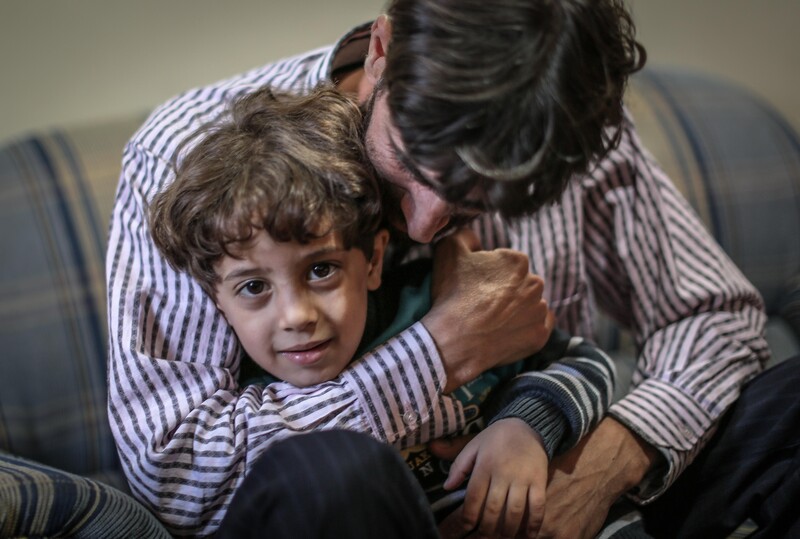The Electronic Intifada Gaza Strip 14 December 2015

Wesam Wehedy, here with his surviving son, and his wife have lost a child after each of Israel’s recent attacks on Gaza.
Rola Fayez Wehedy has lost three babies, each dying after one of Israel’s recent large-scale assaults on Gaza.
After losing the third, she decided not to try again. She told The Electronic Intifada that the pain of watching the last newborn baby gasping for breath, the pink draining from her delicate cheeks before they turned blue, was too unbearable to risk suffering through again.
“The last day was the hardest,” her husband, Wesam, said. “We watched her bleeding from the nose and mouth before she stopped breathing altogether.”
Sitting in his home in Gaza City, his three young children vying for his attention, Wesam slowly recounted the three wars he and his wife survived — and their babies who didn’t.
Two babies, one born soon after the winter 2008-2009 war and the other after the summer 2014 war, died before they were two weeks old. Both were diagnosed with what Wesam and Rola believed to be a rare congenital heart disease. A third was stillborn in 2013 following Israel’s attack on Gaza in November 2012.
The couple’s surviving daughters were born before 2008 and Younes, the youngest, was born in late 2010.
It was not until Wesam and Rola met with Dr. Shireen Abed, head of the neonatal intensive care unit at al-Naser hospital in Gaza, that they learned their babies’ heart condition is not so rare in Gaza after all.
In October, Abed released a study analyzing the trends of congenital heart disease among newborn babies admitted to al-Naser hospital. Abed, along with three co-authors, conducted the survey after observing an uptick in the number of babies born with anomalies being admitted to their ICU after wars on Gaza.
Environmental toxins
The study showed that there was a statistically significant spike in the incidence of congenital heart disease in babies born directly after a war.
“This could be attributed to the environmental toxins they are exposed to during the wars,” Abed told The Electronic Intifada.
“All of us here are exposed to toxins that are carcinogenic,” Abed said, “but babies are particularly vulnerable in the first three months of gestation.”
Abed emphasized that there must be further analytical studies done to determine whether the wars’ environmental toxins are responsible for the increase in congenital heart disease among newborns.
White phosphorous
Wesam recalled his and Rola’s baby who died at only 12 days old in April 2009. Rola was five months pregnant with that child when Israel bombed a mosque close to their home with white phosphorous.
“After the phosphorous explosion she didn’t feel the same,” Wesam said, referring to his wife. At the time, neither he nor anyone else he knew in Gaza understood how potentially perilous exposure to white phosphorous was for them and their unborn baby.
During last summer’s assault, when Rola was pregnant, Wesam said there were nights when his neighborhood was literally on fire.
“These were mythic nights; the strikes made a huge noise when they hit the ground and left an acrid smell that would last for days,” he said. “I kept thinking, if they targeted our house, which ones of my family would I help escape.”

Rola and Wesam Wehedy’s surviving daughters were both born before Israel’s winter 2008-2009 attack on Gaza.
While difficult to measure, artillery fire and airstrikes leave a toxic imprint on the landscape that lasts for years, particularly in places where rubble is not quickly cleared away. Abed’s research notes that an increased prevalence of birth defects are reported in countries after wars.
Abed is eager to conduct follow-up research on her preliminary study, but she said it’s difficult to do so in Gaza.
“We have limited resources and facilities. We need to collaborate with doctors in other countries,” she said.
Abed’s office is surrounded by three separate neonatal rooms holding newborn babies at different stages of stability. All of the babies in the neonatal unit are younger than 28 days old — the most fragile period of life, Abed said.
The challenges faced by Gaza’s newborn babies and their mothers do not end with survival of Israeli bombing.
Siege
Dr. Allam Abu Hamda, the head of the neonatal intensive care unit at al-Shifa hospital, Gaza’s largest, said that due to the Israeli blockade, the Strip’s medical facilities significantly lag behind in modern technology.
“Everything here is in shortage. There’s not enough staff, medicine or equipment to take care of the expanding population,” Abu Hamda said, noting that the last time the public hospitals were renovated was 20 years ago.
Abu Hamda said that doctors are not able to obtain specialized education to treat babies born with rare diseases or special conditions, and the hospital staff is inadequately trained in neonatal life support. Meanwhile, medical equipment and materials are often insufficient to care for newborns with special needs or in critical condition.
“Neonatal care should be more specialized, with years of training, but medical staff here are not allowed to leave Gaza in order to get updated information and training,” he said.
Abu Hamda added that since his staff began specialized training in 2013 in collaboration with Medical Aid for Palestinians, a British charity, the mortality rate among newborns has been halved.
But he is very concerned about the increase in numbers of babies born with anomalies, like those in the Wehedy family.
“We need to determine if these anomalies are related to family disease or a new mutation that is related to the environment,” he said.
But for Wesam and Rola and families like theirs, that point may be moot.
“Two daughters and one son, this is enough. It’s a blessing,” Wesam said, with resignation.
Charlotte Silver is a journalist based in Oakland, California. Twitter: @CharESilver.





